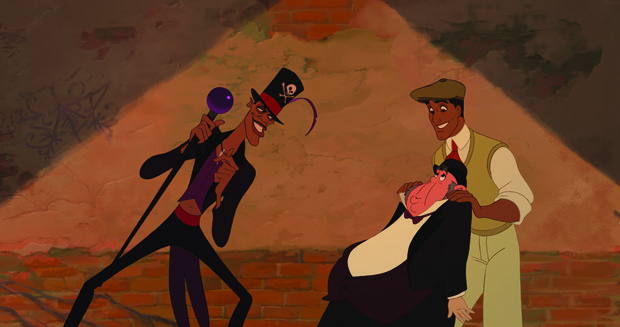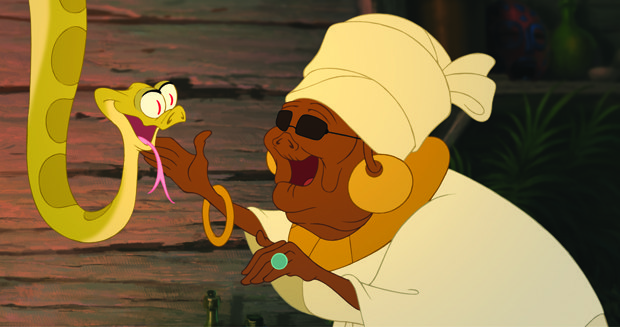Traditional animation is definitely back at Disney and the directors of The Princess and the Frog give us a sneak peek.
Check out The Princess and the Frog trailers and clipsat AWNtv!
Ron Clements and John Musker were thrilled on a recent Friday afternoon. The directors had just finalized color for their long-awaited return to 2D animation at Walt Disney Animation Studios: The Princess and the Frog. Not surprisingly, their giddiness spilled over into a roundtable discussion with a half-dozen online journalists, who were first treated to a special VIP press tour of Disneyland and the studio's animation archive to get us in the proper mood. We then viewed additional footage from what was already shown at Comic-Con and D23. As they head into the home stretch, the directors discussed the genesis of the movie (an amalgam of projects inspired by the Grimm fairy tale developed at both Disney and Pixar); what it's been like rejuvenating the studio's vaunted hand-drawn, musical fairy tale tradition the second time around; and how this classical New Orleans feast differs from The Little Mermaid. Meanwhile, they divulged that another traditional feature is already in the works, and that they are pursuing other 2D projects as well. AWN s ubsequently learned that there will be no animated short accompanying The Princess and the Frog (opening in limited release Nov. 25 in L.A. and New York and going wide Dec. 11).
Bill Desowitz: This is the second opportunity for the two of you to usher in traditional animation at Disney, but technology has allowed you to raise the bar aesthetically. What's it been like this time around?
John Musker: Certainly it was odd to start it up again because they kind of mothballed the CAPS system, which is what we used…
Ron Clements: Mermaid was the last film done with cels -- the sort of traditional way. Every movie up to that point, the drawings were Xeroxed onto celluloid, painted on the back and then filmed over painted backgrounds. And then Rescuers Down Under, which was the next film, was the first film to use the CAPS system, which was digital ink-and-paint and composited. And that continued until things kind of went away.
JM:
And so we used a production software system on this movie called Harmony, which is a product of Toon Boom. And we did something on this film, which we hadn't done on any of the previous films, which sounds pretty simple but it actually helped us get richer colors and more interactive backgrounds and characters. Our characters were painted almost like in a neutral light before we picked the color that would be in a scene, which isn't the way we ever did it before. Before, we would literally [work] on a scene that was ready to go into color; we would have color models and take a frame from the film and would paint the characters in a frame or two from a scene and go, "That's what they're going to look like over those backgrounds." And then it would go off and be painted -- whether or not it was by hand or artists doing it on the computer. And that's what we lived with, other than dialing it up or down in color timing.
Now, with this new system, the characters are painted in neutral colors and then, in our color model area, [we] take those characters and adjust them for that background, and we can play it back in realtime and see this is how that character works in that environment and actually play the scene as you would see it on screen. And they can do all sorts of things interactively, with gradients…
RC:
Like what a painter would do. It really is an artistic thing where they can take the bare bones and enhance it in just a lot of ways, some subtle, some less subtle. It's just really, really nice…
JM: And if we decided that we didn't like the color, with this new system they don't have to repaint the entire scene; they just push a button and from now on that shirt is red. And in the old system, you'd have to take out every cel or in the computer every drawing and physically repaint each one and go to the next one…
RC: I would say the mandate when we first started -- and that came from John Lasseter -- was to aim high in every area: animation, color, layout, backgrounds, effects to do it as well as could possibly be done. Everyone really strived in all of their areas to reach as far as possible.
JM: In terms of the production process, I would say two things at John Lasseter's behest. One thing they do at Pixar is use animatics. We use story reels. What John wanted us to do is a more interactive thing like they do at Pixar. They do these wireframe models that block out that scene so you get an idea of the cutting even though there is no animation.
BD: So, how did this work on your movie?
RC: So we had this new innovation we called the "layout animatics," where we actually put it on film and could watch it like a movie that goes beyond the story reels. There's still no animation; but all the cutting is there, the characters are still drawings, but the camera's moving and the lighting is there. It gives you a chance to see the movie in a much more realized form before the animation is done. And I would just say there were a lot of benefits that came out of that.
BD: So your scenes would be shot and timed as animatics?
JM: Yes, it was actually an added step to the process…
RC: It actually slowed down the process in the early stages but it was more than worth it and it just elevated the filmmaking: there were less redos of things because the animators could look at the animatic and could see exactly how the shot was going to work and know everything in advance. We could still make changes; there's nothing about the process that doesn't mean you can't plus it but it was a way of seeing it.
BD: What classic Disney films informed your look?
RC: Very early on we zeroed in on Bambiand Lady and the Tramp: elements of both those films that we liked. Lady and the Tramp for New Orleans and Bambi for the bayou. Those are not the same style but in terms of character design, they both have a dimensional and very appealing [look]. I think John said that a certain kind of Disney animation reached its peak with Lady and the Tramp. In a way, that's the most sophisticated version of classic Disney animation, a sort of rounded beauty…
JM: Then Sleeping Beauty was the next feature and everything was flatter…
RC: Which was a stylistic choice to emphasize the sort of graphic nature of the drawing. So we went back to the more dimensional drawing.
JM: And the idea of backgrounds that had atmosphere, which is why we looked at Bambi. And on Lady and the Tramp they found ways of simplifying architecture that implied more than what was painted in terms of the city and those Victorian houses.
RC: The same was true of Bambi dealing with a forest where there was a lot of Impressionism and lighting that emphasizes what you're supposed to look at and de-emphasizes what is not important.
JM: And our art director is Ian Gooding and he did a great job of designing the color of the movie and I think our palette is very rich and saturated and our story ranges from areas in the bayou to areas in the city, so we've got some comedic things, some scary moments, so it gave the color palette a very broad area to work at. It seemed to fit New Orleans.
RC: It is a bit of a gumbo -- a bit of a Disney gumbo. And right from the get go, gumbo is a big, popular dish in New Orleans, but it's also a metaphor for this [unique] city with so many different cultural elements fused together.
BD: What was it like assembling this animation crew, a combination of veterans and newcomers?
RC: One of the really great things about this movie was the opportunity to put a dream cast together, which couldn't have been done 10 years ago because when hand-drawn animation was at its peak -- well, maybe more than 10 years ago -- they were spread out at other studios and Disney split up its own staff with multiple productions going on at the same time. So no one worked on the same movie. On this one, we were, with a few exceptions, able to get everybody we wanted, partly because there were no other hand-drawn features being done anywhere else. And even though many people were successful in digital animation, everyone who worked in this kind of art form wanted to return to it. They missed it…
JM: People like Andreas Deja and Eric Goldberg, who we had worked with before. But then we had a great animator like Bruce Smith, who we had never worked with before, but he was a veteran who brought so much to the character of Dr. Facilier [the Voodoo villain].
RC: And Mark Henn, who had moved to Florida. He worked on Tiana.
JM: But, as you say, we also had newcomers like Hyun Min Lee, who worked with Eric Goldberg [on Louis, the jazz playing crocodile], a student right out of Cal Arts and did the Jules Engel program and a wonderful animator. And it was great having these guys in their twenties working alongside these veterans in their fifties. They really took to it and it was great to see people embrace this who might otherwise go in a different direction.
Bill Desowitz is senior editor of AWN & VFXWorld.














